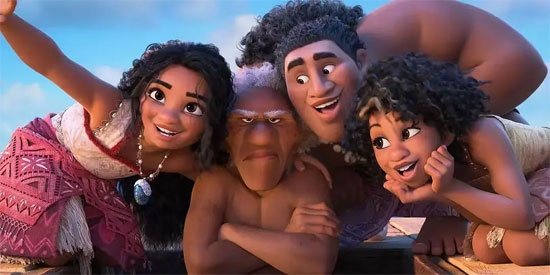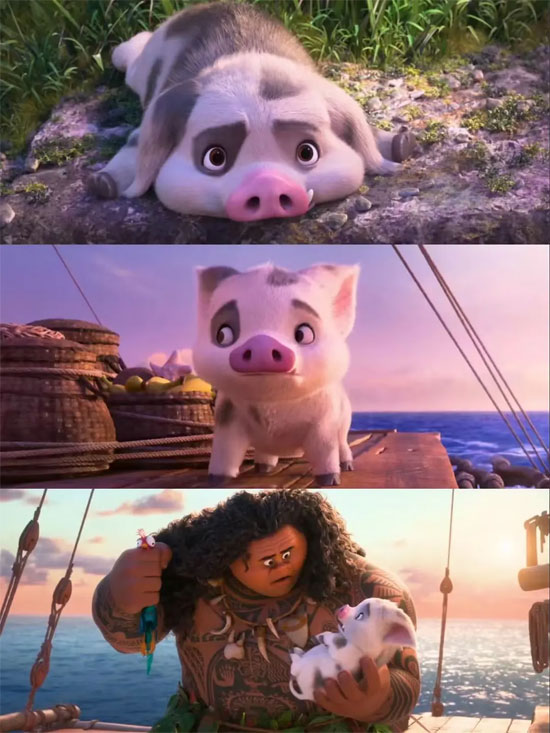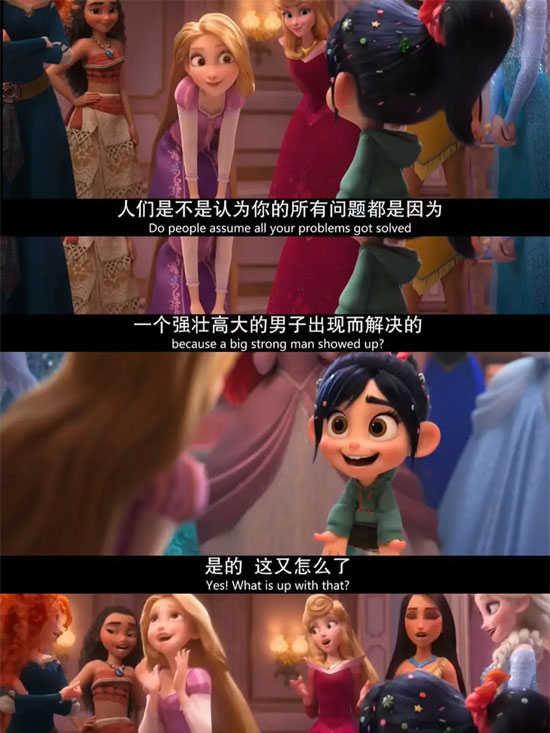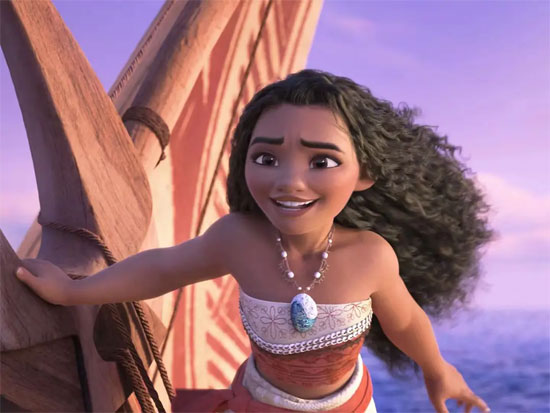Film Name: 海洋奇緣2 / Moana 2
Set three years after the events of the first film, Moana receives a call from her ancestors to embark on a new adventure across the Pacific, venturing into treacherous waters. Her mission is to “unite the scattered tribes across the ocean,” confronting terrifying new adversaries and natural threats unlike any before. In this journey, Moana must confront ancient curses and vanished islands while leading her companions through raging storms to avert a catastrophe capable of engulfing the entire ocean.
“Moana 2” introduces numerous distinctive new characters that not only advance the plot but also deliver compelling entertainment value. These include the lively and brilliant shipwright Loto, the cool and adorable coconut pirate Kato, Maui’s dream-man Moni, the elderly farmer Kele, and the bat-woman Matangi. Compared to its predecessor, the film crafts a richer ensemble story. Simultaneously, it constructs numerous new settings, presenting audiences with an underwater world brimming with fantastical charm and adventurous spirit.
New Characters in “Moana 2”

Many believe that “Moana 2” isn’t worth the ticket price, falling victim to the “sequel curse” like other Disney films. I can’t argue with that assessment. Compared to the first film, the sequel falls short in narrative structure, pacing, and thematic depth. Musically, it also pales slightly without the involvement of Lin-Manuel Miranda. Furthermore, as a sequel to a Disney fairy tale, “Moana 2” inevitably falls into a formulaic approach. Upon closer examination, its plot even shares striking similarities with “Frozen 2.” However, as a devoted fan of Disney’s predictable storytelling, whether the plot follows a formula doesn’t significantly impact my enjoyment of the film. Moreover, I believe “Moana 2” still has many commendable aspects, so I award it 4 stars.
Compared to the first film, “Moana 2” is highly suitable for children, offering educational value through its exploration of human-nature relationships and feminist themes. The visuals remain exquisitely crafted, showcasing the breathtaking wonder of the underwater world. I sensed the director’s vision of “harmonious coexistence between humanity and nature” expressed throughout the film. Moreover, it subverts the stereotypes found in many previous Disney princess films, showcasing Moana’s courage, wit, and feminine strength as both a “princess” and a woman. This article will focus on analyzing the philosophical ideas about humanity and nature embedded in the film, as well as the feminist themes presented in Disney’s new generation of princess movies.
I. The Sea as Destiny: Exploring Human-Nature Relations and Māori Culture in Moana’s Narrative
Within the film, the sinking of an island is attributed to divine intervention; similarly, the ocean’s deterioration threatening Moana’s tribe stems from the gods. This framework inevitably draws attention to the film’s cultural foundation—Māori mythology. Māori mythology is inseparable from the natural world inhabited by the Māori people, where divine presence permeates every element—wind, sea, sky, volcanoes, and more. The “Moana” series offers a comprehensive portrayal of Māori mythology, beginning with the demigod Maui. His origins trace back to Māori mythology: the Maui myth. In the myth, Maui was born prematurely, an unformed creature. His mother, terrified by this monstrous infant, cut off her own hair, wrapped him in it, and cast him into the sea—a narrative that aligns with the tattoo on Maui’s back in the film. The myth also recounts Maui stealing the source of life—the heart of the goddess—which forms the plot foundation of the first film. The author speculates that the story of Maui hooking an island in the second film originates from a tale about New Zealand’s North Island. (In the story, Maui hooked a giant fish that became the North Island of New Zealand.) These scenes of deity worship in the films both reflect traditional Māori beliefs and explore the philosophy of the relationship between humans and nature.
Aristotle posited that the soul is the essential characteristic of living beings—all life possesses a soul, which serves as both its defining essence and intrinsic driving force. This concept resonates with animism’s belief that all things possess a form of spirit or vital force. The author speculates that the filmmakers may have been influenced by similar philosophical ideas during production. The five elemental spirits in “Frozen 2” stand as the most compelling example of Disney’s creative process being shaped by Aristotle’s philosophy of universal life. Indeed, nearly every Disney film features animals endowed with distinctly human traits. Tracing Disney’s evolution, from the animals in Snow White to the mouse in Toy Story, these creatures speak, possess human emotions, and perceive human feelings. Moreover, many times, even inanimate objects are anthropomorphized (such as the teacup and candles in Beauty and the Beast). This characteristic is no exception in Moana 2. The piglet Pupu, who feels sad when eating pork; the lively, vibrant ocean, which also has its own little temper like a human; and the well-trained coconut shell pirates all convey a philosophy of “animism.”

Notably, while embodying Aristotelian philosophy, Moana 2 also effectively illustrates the Marxist perspective on the relationship between humanity and nature. Marxist philosophy posits that humans and nature form a unified whole, with nature serving as the foundation for human survival and development. Through labor, humans engage in material exchange with the natural world, forging an organic unity with it. This philosophy emphasizes nature’s primacy and humanity’s dependence upon it. In the film, Moana’s tribe initially harbors profound fear toward the ocean, viewing it as dangerous and insurmountable. After Moana breaks the curse and reveals that their ancestors possessed the ambition to conquer the sea, her people rediscover their calling to sail. By the second film, Moana’s tribe has begun fishing at sea and utilizing the ocean for their livelihoods. Simultaneously, they hold a profound reverence for the ocean, naming Moana “Tautai” (meaning: the Navigator) and conducting related ceremonies—all expressions of their tribe’s respect for nature. When Moana, Maui, and her people unite to confront the gods, pulling the island from the sea to reconnect humanity, it embodies humanity’s proactive agency in the face of nature.
The portrayal of Maori spiritual reverence for nature and their philosophy in “Moana” may offer educational insights and inspiration to both young and adult audiences. Amidst escalating global environmental challenges, rediscovering our roots, understanding the spiritual essence within nature, respecting it with awe, and utilizing it wisely may be our best course of action.
II. The Queen of the Sea: The Evolution of Gender Discourse in Disney Princesses
In the film “Ralph Breaks the Internet,” a pivotal scene unfolds when Vanellope enters the princess lounge. Rapunzel asks, “Do people think all your problems get solved just because some big, strong guy shows up?” Vanellope replies, “Yeah, so what?” The princesses respond in unison: “She really is a princess.” ” This official retort perfectly captures the portrayal of princesses in earlier Disney films, where they often required a “prince’s” love to grow and their difficulties were typically resolved by a “prince.” But Moana shows us another possibility for a “princess.” She can be a tribal chief, a legendary navigator of her tribe, and her challenges no longer need “him” to solve them.
The plot of “Wreck-It Ralph 2”

Compared to the naive young girl in the first film, Moana in the sequel reveals a wiser and more powerful side. She uses her intelligence to redeem her family, her people, and even all of humanity, defeating the demigod to reunite the entire human race. This undoubtedly represents another attempt by Disney to completely subvert the traditional stereotype of the “princess.” Her relationship with Maui also moves beyond the clichéd dynamic of one rescuing the other, evolving into more of a comrade-in-arms or partner, where they encourage each other and grow together. In the first film, Maui wasn’t even the savior of the situation—he was the one who caused the disaster (by stealing the Heart of Te Fiti). More intriguingly, the second film shifts the role of the rescued to a male character: Moni, a ruggedly masculine figure, is pulled from the sea by Maui.
In the film’s climax, it is not Maui who ultimately lifts the island. Moana takes the leap, diving beneath the waves to step onto the sacred land and break the demigod’s curse. Moana redefines the Disney princess archetype. She needn’t be demure or preoccupied with romance. Though aware of her journey’s dangers and torn by familial bonds, she bravely sets sail to conquer the ocean. Her vision extends beyond personal love, family, or tribe—she pursues a greater cause: reuniting all humanity. I’m thrilled to see more films featuring diverse portrayals of women. As I’ve said, they’re no longer just princesses—they can love adventure, possess leadership qualities, and demonstrate unwavering resilience.
Moana standing on the sailboat

What delighted me even more was witnessing the filmmakers’ portrayal of female characters in the movie. The Grandmother, Moana’s guide: She holds immense significance in Moana’s life, embodying unwavering and courageous feminine strength. Her character mirrors the female leaders within a matriarchal society. She possesses the rare ability to communicate with the ocean and becomes the first and only clan member to support Moana’s quest to sail the seas. After her death, she transforms into a manta ray, appearing with a blue glow whenever Moana faces danger to offer her greatest assistance. Grandmother is also the character in the film who drew the most tears from the author. Supporter: Mother. Like the grandmother, Moana’s mother embodies resilient feminine strength. Knowing the ocean’s dangers, she still supports Moana in pursuing her dreams. It is precisely this maternal support that gives Moana the courage to explore the world. Creator: Te Fiti. As a new character introduced in “Moana 2,” Te Fiti delivers many standout moments in the film. As a shipbuilder, she possesses remarkable creativity. She designed all the vessels Moana sailed in, each iteration more refined than the last. Her courage shines through when, facing the divine storm, she decisively cuts down the sails and reshapes them into parachute-like structures to accelerate the raft’s speed. I nearly shouted in unison with Moana: She’s a genius! These diverse female characters showcase a new direction in Disney’s portrayal of women. They are no longer evil stepmothers or villains, but a community of women supporting each other to become their best selves.
Just like Moana in the film, women in real life possess their own abilities and value. They are resilient, courageous, and goal-oriented, capable of using their wisdom and strength to solve problems they encounter. We should trust and support them fully, just as the film does, rather than standing by with a know-it-all attitude, assuming “you don’t understand anything” and engaging in baffling behaviors like “let me test you.”
Overall, “Moana 2” has met my expectations. It delivers laughs, tears, and moments of pure excitement. While not as profound as some films and not without its flaws, it resonated with me emotionally. I found myself connecting with its philosophical themes and the potential it portrays for women. Though the plot devices feel somewhat formulaic and familiar, it still offers fresh possibilities. It’s a highly worthwhile animated film to take children—especially young girls—to see.
Please specify:Anime Phone Cases » Moana 2 2024 Film Review: From singing before the mirror to battling the ocean—they are no longer just “princesses.”